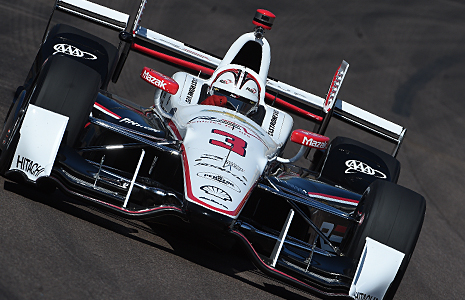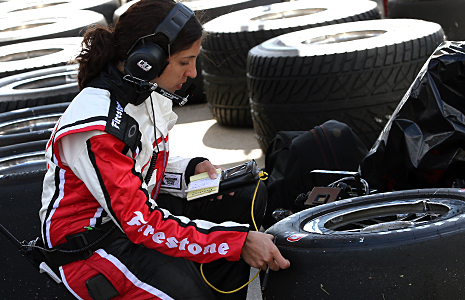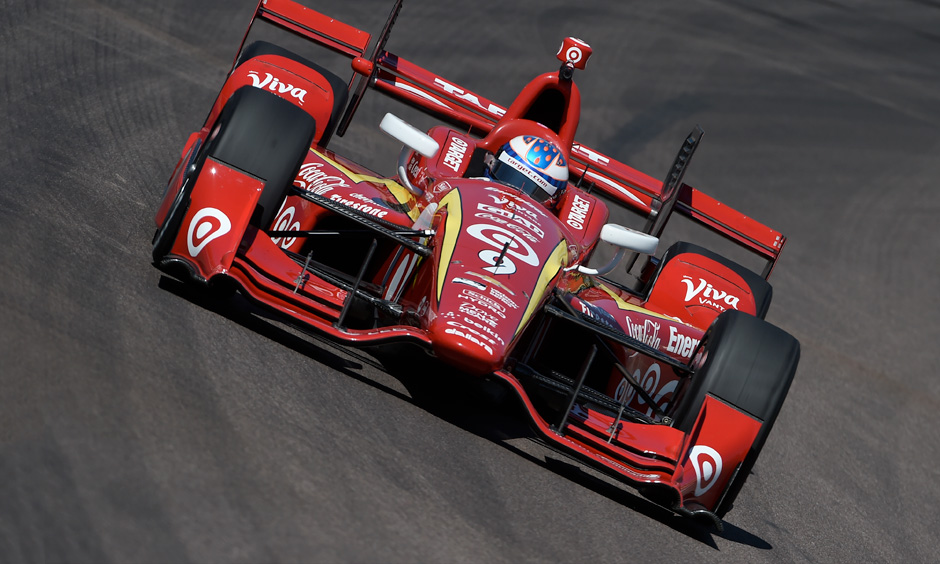INDYCAR Voices: The lowdown on short oval downforce
JUL 05, 2016
(This is the second of a three-part series from Verizon IndyCar Series driver JR Hildebrand.)
In my last column, we kicked off a basic conversation about Indy car downforce. We talked about downforce in general terms, learned how we measure it for comparison (in downforce at 200 mph) and looked at how the relationship between downforce, drag, and power affects lap time in the context of road and street courses. In this installment, we’ll see how downforce affects the car on a short oval and look at other factors outside of just downforce, drag and power that impact the equation.
Road and street courses are really the most straightforward tracks to have this discussion around because the cars are constantly accelerating, braking, cornering and re-accelerating. The lap on a road course is very segmented in this way – it’s less about momentum around the track, and more about getting from A to B to C as quickly as possible, where each phase of each corner could be viewed as somewhat independent.
Because of this, an increase or reduction in downforce, drag, and/or power predictably impacts the car’s performance per phase of the corner. We saw that taking away downforce and drag in relatively significant fashion (reducing by nearly 40 percent from 6,500 pounds to 4,000 pounds) made for a net loss in performance due to how much time was lost while braking and cornering, but the car did have more top-end speed without additional power. Even with that top-end speed advantage, however, we required roughly an additional 35 percent more power (up to around 950 horsepower) to fully recover the speed that was lost under braking and cornering.
Now, shifting our thinking to how this all works on a short oval, let’s look at how it’s fundamentally different from the road course study. While a road course is not particularly momentum-based in terms of lap time since the lap is separated into a bunch of unique corners, a short oval is very momentum-oriented as it’s almost continuous cornering. Any deceleration and much of the acceleration that occurs on a short oval track happens while cornering. The corners on a short oval also have a very large radius, which in addition to banking and the fact that the cars can be asymmetrically set up to maximize their ability to turn left only, make for higher speed cornering than any road course out there. And we know that as speed goes up, so does downforce at an increasing rate, which means the cars are constantly generating and relying on a lot of downforce.
So the moral of the story here is that, compared to a road course, the amount that a car’s ability to corner matters on a short oval vs. basically anything else is proportionally much higher.
Let’s take Phoenix as an example since that was a track where we saw a lap-record-setting average speed, but what many people thought to be a somewhat processional overly aero-dependent race.
 Helio Castroneves qualified on the pole with a two-lap average lap time of 19.13 seconds (192.32 mph). Indy cars raced at Phoenix with somewhere around 5,500 pounds of downforce but qualified with only around 4,000 pounds, removing downforce - and therefore grip - right to the limit where drivers could barely go flat-out for two laps (many teams actually overshot this downforce reduction slightly due to conditions being worse than anticipated).
Helio Castroneves qualified on the pole with a two-lap average lap time of 19.13 seconds (192.32 mph). Indy cars raced at Phoenix with somewhere around 5,500 pounds of downforce but qualified with only around 4,000 pounds, removing downforce - and therefore grip - right to the limit where drivers could barely go flat-out for two laps (many teams actually overshot this downforce reduction slightly due to conditions being worse than anticipated).
Teams ran so much more downforce in race trim in order to be better over the course of a full stint – with rare exceptions, average speed over 50 laps outweighs peak outright speed to begin a stint with more significant fall-off.
So for the sake of the conversation, I looked at what would happen if you further reduce downforce from where teams qualified since that was the going-flat-out limit which seems to be a frequently contentious thing all by itself.
On the road course at Sonoma, we reduced downforce (and drag) by 40 percent to 4,000 pounds and saw a 2-second increase (loss) in lap time, equivalent to roughly 2.6 percent. For Phoenix, a mere 25 percent reduction in downforce from qualifying trim (from 4,000 pounds to 3,000 pounds) results in a simulated loss of 3 whole seconds from qualifying.
Given how short the lap is, that’s a 15.5 percent difference. So a much lesser reduction in downforce has a far greater impact because the car is so much more dependent on downforce (for cornering speed) for average speed.
With that big of a deficit to make up percentage-wise, it was actually beyond the capability of the sim program we used to accurately balance the lap time with power alone (it’s not really designed to work outside of halfway normal constraints), but I can tell you this much – doubling the car’s horsepower (to 1,300-1,400 horsepower!!) was only good for a little over a second of lap time at 3,000 pounds of downforce. That just goes to show how little time is spent accelerating in a straight(ish) line on this type of track.
My personal conclusions from this are as follows: 1) taking away downforce without other adjustments on short ovals so that the drivers can’t be flat-out will definitely make the outright average speed slower -- good, bad, or otherwise; 2) the amount of additional power to make up for even a small decrease in downforce (even 5-10 percent) needs to get cranked up at a significant rate to make almost any impact on overall lap time; 3) while optimizing this in some ways sounds appealing, I’m not sure if any of that alone will really address what we’re looking at.
At the end of my previous column, I noted that Indy cars are extremely fast in their current spec, but could maybe be more badass.
I say that in part because the operating window for maximum performance is very tight, and that it has a relatively abrupt drop-off if you overdo it (due to a variety of design factors). This doesn’t make for a car that really appears to be on the edge, despite the fact that it often is.
 A current Indy car with 3,000 pounds of downforce at Phoenix would not just be slower, it would be slower in a way that wouldn’t be much fun to drive. I think there’s a misconception that by reducing downforce at a place like this, we’d end up with cars that are sideways through the corner with guys up on the wheel, visibly hustling the cars around the track.
A current Indy car with 3,000 pounds of downforce at Phoenix would not just be slower, it would be slower in a way that wouldn’t be much fun to drive. I think there’s a misconception that by reducing downforce at a place like this, we’d end up with cars that are sideways through the corner with guys up on the wheel, visibly hustling the cars around the track.
Given that the cars are designed to make a lot of downforce and generate grip in that way, I don’t think that’s what you’d find. Typically speaking, a current Indy car on an oval without enough downforce for its given conditions is a machine that’s a knife’s edge away from succumbing to the dreaded wall magnet. Going faster than the other guys in this situation is more about exceptionally managing than it is about hustling in most cases; the relative risk in hustling due to the very narrow operating window of the car rarely justifies what is, in the best of circumstances, a short-lived reward.
The cars are actually very difficult to drive in these low-grip conditions from not enough downforce, exemplified by the fact that races in this category tend to have a much larger separation in performance with the guy in Victory Lane often being one you’d associate with having great skill and a high degree of pucker-factor tolerance.
So that part of it is kind of what we want, right? But the hard-to-drive-ness doesn’t really translate to the observable driving and racing action that you so want to see when race cars lose grip, or frankly that the drivers want to experience.
So the added part to the equation in this installment is the concept of mechanical grip. We’ll loosely define this as the grip the car generates at the tire without the help of downforce. Very generally speaking, this comes from the compound and construction of the tire itself, combined with the settings of the mechanical setup of the car – shocks, springs, anti-roll bars, heave springs, roll centers, cambers, toes, etc., etc. The mechanical setup directly impacts the way each of the four tire contact patches interacts with the racing surface, so those two things (tire and setup) go hand in hand and are extremely important.
Engineers on INDYCAR teams spend an insane amount of time optimizing the race car’s mechanical grip for every type of track we go to. It’s actually what teams spend the most time developing – it’s the most significant factor for performance that the teams have control of, and the range of adjustability for items that affect mechanical grip is impressively large.
But while INDYCAR teams are incredibly good at filtering through everything they have at their disposal to maximize the car’s mechanical setup, there is inherently a limit to how much mechanical grip the car can create.
 Additionally, as anyone in the series would tell you, the tires we race on from Firestone are incredible. Equally impressive engineering is happening with the tires themselves - they are designed and constructed with INDYCAR’s very specific formula in mind, and are also optimized for it.
Additionally, as anyone in the series would tell you, the tires we race on from Firestone are incredible. Equally impressive engineering is happening with the tires themselves - they are designed and constructed with INDYCAR’s very specific formula in mind, and are also optimized for it.
Now, in an entirely hypothetical situation, what if you could just give the ol' grip knob a turn or two like in a video game? How might that impact our downforce, drag and power equation? Or the converse – how might a change in the downforce, drag and/or power of the car allow the tires to change?
Equally important to this conversation is how these changes could impact the way the cars drive. How sharply does the tire’s tolerance for slip angle drop off? How quickly does the tire recover grip once it’s gone past its limit? How much peak grip does the tire generate vs. how long it takes to degrade? How might we convert the effects of our video game grip know in real life? How would all this impact the operating window of the car?
So while you watch the Iowa Corn 300 this weekend, imagine what it might be like if some of what we’ve talked about here were different and how that might affect your perception of what’s going on. I expect a great race (I really enjoyed testing for my dude JNew (Josef Newgarden) there last week, and was already feelin’ the high line), so make sure to tune in anyway! Next time, I’ll give you the rundown on superspeedways, and specifically Indy.
Get ready to hold on tight, because when we start doing horsepower comparisons there, we’re going to start seriously hauling the mail.






















